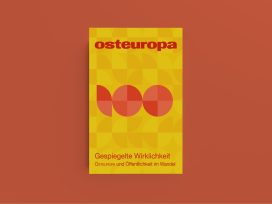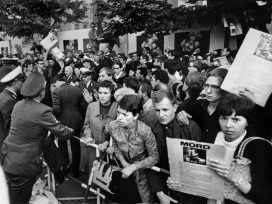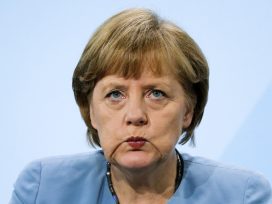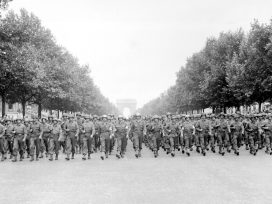Who may exercise inner-state force and under what conditions? Today, even the Left has answered this problem, it seems. It is the state that should hold the “monopoly on the legitimate exercise of physical force”, as the sociologist Max Weber defined it over a century ago. According to current opinion, however, state force is legitimate only if not employed arbitrarily; if “fenced in” by the principles of the rule of law, basic rights, and democracy.
Against this normative understanding, it seems barely comprehensible that in 1968 the radical Left in Germany – along with many of its sympathizers in academia and the media – should have developed an entirely different understanding of the legitimacy of political violence. Why did they end up trusting neither the rule of law nor the institutions of parliamentary democracy? Why did they refuse to hand a blank cheque to the state monopoly on the use of force? And why did they want to pit the counter-violence of the downtrodden against oppressive state force?
Did the radical Left have a psychological defect, as some critics think today? Were they fetishists of violence, existentialist dreamers for whom the use of guns and explosives promised an intoxicating intensification of experience?
Let’s take a look back at a demonstration of German leftwing students in the mid-1960s. We see a gathering of well-behaved youngsters, most from the educated middle classes, who – following the example of their fellow students in the US – are campaigning for freedom of expression on the campus and democratic reforms in the universities. A little later, they flock to peaceful demonstrations in city centres. They protest against the war in Vietnam. They organize, in breach of traffic regulations, sit-down strikes and blockades – in other words, forms of civil disobedience also imported from the US. There are no signs, however, of a challenge to the state monopoly on the use of force, let alone counter-violence.
Unleashed upon this polite troop is a resolute apparatus of force. As though in a civil war, police units, equipped with truncheons, tear gas, and water cannons, bear down on the demonstrators. Accompanying the offensive is a barrage of verbal abuse from the Springer media conglomerate, which calls the students “animals” (“hairy apes”) and “fascists dolled up as communists”.
The deployment of state force against the leftwing rebels met hardly any resistance in German society. Bolshevism generated a widespread horror that was a murky mix of still active Nazi indoctrination and concrete sense of danger. The anti-authoritarian and democratic movement in universities and in the family developed in parallel with the sense of threat forming in society at large around a clearly defined image of the enemy.
In West Berlin, another psychodrama was being played out. The vast majority of the population saw the critique of the Vietnam War as an elementary violation of solidarity with the US, which had “rescued West Berlin from the communists” during the Berlin Blockade. Moreover, student activism had dented the heroic self-image of West Berliners, who wondered whether they had seen off the threat of a communist invasion in order to be made fools of by leftwing students.
Until 2 June 1967, when the student Benno Ohnesorg was shot dead by a policemen (by no means in self-defence), student activism was playfully noncommittal, a cunning game of cat and mouse played with the police. Afterwards, everything changed. The state had committed murder and then tried to cover its tracks. When the leftwing opposition, following its own investigations, revealed the truth, the matter was clear-cut: the rule of law had failed.
From that moment on, the death of the Ohnesorg was no longer seen as an isolated offence but interpreted against the background of the political conflict over the Emergency Act (Notstandsgesetz). The act, passed in 1968, limited the ambit of the basic law in states of emergency, which included “domestic emergencies”.
Peace in Vietnam, weapons for the Vietcong
The leftwing rebels were faced with a depressing scenario, namely the ability of the authoritarian police and security state to establish itself within a parliamentary democracy and erode it from within. What was to be done? The leftwing students, along with parts of the trade unions grassroots, advocated an illegal general political strike. The attempt failed.
And then there was the war in Vietnam. Despite democratic institutions and an independent press, the US army had committed a succession of war crimes and in three countries in Indo-China had wiped out entire populations. In the eyes of the Left, the Vietnamese people, represented by the National Front for the Liberation of South Vietnam (NFL) and North Vietnam, were fighting a war of liberation. At the universities, calls for peace in Vietnam were as common as whip-rounds for “weapons for the Vietcong”. The use of violence by the Vietnamese and other liberation fronts counted as fair game. Unlike the peace movement of the 1980s, the radical Left of 1968 overwhelmingly supported the notion of just war, particularly in cases of anti-imperialist struggles that would give rise to social liberation and democracy. The anti-Hitler coalition was viewed as an historical reference point. The notion of non-violence in principle was a minority position during this period.
The radical Left believed in action and in praxis, but also in books. All experience had to be understood and classified theoretically. However, as a complex of phenomena, the use of violence resisted simple categorization. While at the international level, solidarity with nations engaged in anti-imperialist struggles may have gone without saying, what about the use of violence by the radical Left in the capitalist metropoles?
This debate, which had been smouldering since 1967, was conducted using both strategic-utilitarian and ethical categories, which often became blurred and displaced – not least in the minds of their protagonists. Tilman Fichter, a leading activist of the Berlin SDS (Sozialistischer Deutscher Studentenbund), recently formulated it thus: “Over breakfast, Rudi Dutschke could be a convinced pacifist and by lunch could consider revolutionary violence to be necessary. Quite honestly, in these debates each of us advocated a different position.”
From the strategic-utilitarian viewpoint, the use of violence in conditions of advanced capitalist-industrial societies seemed inappropriate as long as the authoritarian state did not abandon its own bourgeois parliamentary constitution and pass over into systematic terror. Until then, the scope of radical Left activism was not to include anything that threatened the life or the health of police or security forces. The view of the radical Left was that the forms of activism espoused by the anti-authoritarian revolt, including organization into self-governing groups, the mass rejection of individualizing bourgeois careers, and the sabotage of bureaucratic apparatuses, rendered the use of violence unnecessary in a country such as West Germany.
Alongside these strategic considerations existed an ethical line of argument expressed in the slogan: “Violence against things: yes. Violence against persons: no.” This solution could be understood as an ethical maxim. It was to be expected from a movement that had radicalized in reaction to the violation of ethical norms that the principle of “non-violence against people” was incontrovertible.
The only problem was that, given the intensity of the conflict with the state, this differentiated definition of violence was difficult to maintain. That became clear in the ultimately unsuccessful blockade of the Springer Press after the assassination attempt on Rudi Dutschke, where it was impossible to differentiate clearly between violence against things and violence against persons.
The dilemma became clearer still after the protests against the ban placed on the extra-parliamentary lawyer Horst Mahler at the end of 1968. In the course of the so-called “Battle of Tegeler Weg”, many police were injured by flying cobblestones. This was considered to be legitimate self-defence, as proof at last that the police could not herd the protesters like sheep. A precedent for counter-violence was set that removed the ethical component from the fragile distinction between violence against things and violence against persons.
No pause for thought
Numerous plenum debates such as those held by the SDS throughout 1967 and 1968 evidenced an attempt to get a conceptual as well as a practical “handle” on the question of violence. The original intention of the radical Left was that all activism would be based on the principle of unity of action and (subsequent) reflection. This would help avoid an uncontrollable cycle of action and reaction and prevent violence from developing its communication-deadening potential.
Why was that no longer possible? A coherent leftwing public, which for a long time had been an effective instrument of democratic debate and control, quickly fell apart. Subcultures developed that no longer imagined themselves to be accountable to any such public. Decisive, however, was the mentality prevalent in all extra-parliamentary groups that opposed thorough reflection about the course of action embarked upon.
At the end of 1968, a group centred around the theologian Helmut Gollwitzer called for a temporary halt to all extra-parliamentary activism in order to allow pause for thought. However, what radicals needed most was precisely what was most unpalatable to them. Things always had to continue, to move forwards. Strike the iron while it’s hot: the revolution doesn’t take time off. Could this delusion have been avoided? For sure. But that would have required a developed leftwing political culture in Germany.
The solution to the violence dilemma was a decisionist act: the foundation of the Red Army Faction (RAF). Its advocacy of armed struggle in the western metropole was rejected by almost the entire radical Left. That included groups that wished to fight for socialism from within the bourgeois state, such as the dogmatic communist groups, which associated revolutionary violence with the revolt of the proletariat. They dismissed the RAF attacks as counter-revolutionary on the grounds that they were carried out at the wrong time by the wrong people – using the same old utilitarian arguments, in other words.
It was only with the success of the ecological movement in the second half of the 1970s that the situation changed. One of the pillars of the nascent Green Party was the insistence on non-violence as a matter of principle. The overwhelming majority of the activists of the 1960s subscribed to this postulate, thereby demonstrating that they had learned from the ambiguous outcomes of revolutionary violence in the twentieth century. However, this almost noiseless transition relieved those formerly on the radical Left of an all too painful obligation to engage with their previous positions.
Nevertheless, the affirmation of the principle of non-violence did not mean the unreserved acceptance of the state monopoly on the use of force “without ifs and buts”, as former interior minister Otto Schily put it. The reason for this reservation was rational. There was a risk that handing the state carte blanche for the use of force would also mean having to accept its concrete manifestations. Not to mention the imperative of any leftwing politics to limit and to correct state force via new forms of violence prevention and conflict resolution.
Today, in the era of the “war on international terrorism”, little remains of this leftwing critical reserve. The gains achieved by the principle “yes” to the state monopoly on force have a flipside. The preventative security state, which blurs the boundaries of the state monopoly on force and thus endangers democracy, hardly needs to reckon with opposition from society.







